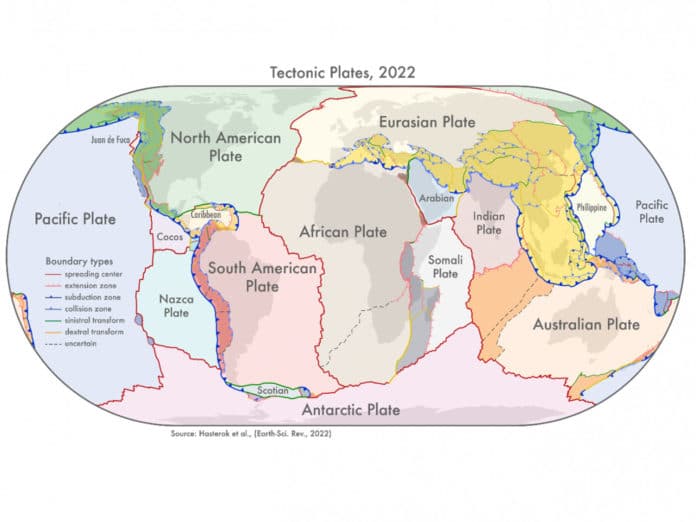Accurate spatial models of tectonic plates and geological terranes are essential for analyzing and interpreting a wide variety of geoscientific data and developing compositional and physical models of the lithosphere. In a new study, scientists at the Universities of Adelaide, Tasmania, Nevada-Reno, and Geoscience Australia, created new models for tectonic plates that offer fresh insights into the history of the Earth.
The models show how the continents were assembled. Compared to existing models, it improves the correlation between an observed earthquake and volcano occurrences within deformation zones and microplates.
Dr. Derrick Hasterok, Lecturer, Department of Earth Sciences, University of Adelaide, who led the team that produced the new models, said, “We looked at the current knowledge of the configuration of plate boundary zones and the past construction of the continental crust.”
“The continents were assembled a few pieces at a time, a bit like a jigsaw, but each time the puzzle was finished, it was cut up and reorganized to produce a new picture. Our study helps illuminate the various components so geologists can piece together the previous images.”
“We found that plate boundary zones account for nearly 16 percent of the Earth’s crust and an even higher proportion, 27 percent, of continents.”
“Our new model for tectonic plates better explains the spatial distribution of 90 percent of earthquakes and 80 percent of volcanoes from the past two million years whereas existing models only capture 65 percent of earthquakes.”
Scientists created three new geological models: a plate model, a province model, and an orogeny model.
26 orogenies (mountain-building processes) have left their mark on the crust’s current architecture. Many, but not all, of these are connected to the creation of supercontinents. This new work allows scientists to map tectonic plates and the formation of continents.
The Macquarie microplate, located south of Tasmania, and the Capricorn microplate, which separates the Indian and Australian plates, are among the additional microplates in the revised plate model. Other data (precise) was added to further enrich the model about the boundaries of deformation zones: previous models showed these as discrete areas rather than broad zones.
Dr. Hasterok said, “The biggest changes to the plate model have been in western North America, which often has the boundary with the Pacific Plate drawn as the San Andreas and Queen Charlotte Faults. But the newly delineated boundary is much wider, approximately 1500 km, than the previously drawn narrow zone.”
“The other large change is in central Asia. The new model now includes all the deformation zones north of India as the plate bulldozes its way into Eurasia.”
“Our new model for tectonic plates better explains the spatial distribution of 90 percent of earthquakes and 80 percent of volcanoes from the past two million years whereas existing models only capture 65 percent of earthquakes.”
“The plate model can be used to improve models of risks from geohazards; the orogeny model helps understand the geodynamic systems and better model Earth’s evolution, and the province model can be used to improve prospecting for minerals.”
Journal Reference:
- Derrick Hasterok et al. New Maps of Global Geological Provinces and Tectonic Plates. DOI: 10.1016/j.earscirev.2022.104069
